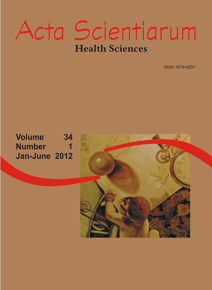<b>O uso de academias da terceira idade por idosos modifica parâmetros morfofuncionais?</b> - doi: 10.4025/actascihealthsci.v34i1.8354
Résumé
O objetivo do estudo foi analisar as características morfofuncionais de usuários de Academias da Terceira Idade (ATIs) na cidade de Maringá, Estado do Paraná. O estudo contou com 86 indivíduos (28 homens (67,8 ± 5,4 anos) e 58 mulheres (67,6 ± 6,0 anos)). Os parâmetros morfofuncionais foram divididos em antropométricos (Índice de Massa Corporal - IMC e a Relação Cintura-Quadril - RCQ) e funcionais (níveis pressóricos - PA). Foi usada a estatística descritiva para tratamento dos dados. Em relação ao estado nutricional, homens apresentaram valores maiores de IMC em comparação às mulheres. Quanto à distribuição regional de gordura, as mulheres apresentaram RCQ mais alto quando separados pelos diferentes estratos, embora em valores absolutos a média masculina tenha sido maior. Quanto a PA, homens mostraram tendência de valores mais elevados, mas ambos os gêneros tiveram reduções nos valores de PA na reavaliação, especialmente as mulheres. É possível concluir que o período de três a seis meses de prática nas ATIs não foi capaz de produzir mudanças significativas nos parâmetros morfológicos de indivíduos acima de 60 anos, independente do gênero. Modificações na função cardiovascular sinalizam importantes reduções nos níveis pressóricos, indicando que a prescrição individualizada e a regularidade de atividade física são essenciais para a obtenção de melhoras mais expressivas.
Téléchargements
DECLARAÇÃO DE ORIGINALIDADE E DIREITOS AUTORAIS
Declaro que o presente artigo é original, não tendo sido submetido à publicação em qualquer outro periódico nacional ou internacional, quer seja em parte ou em sua totalidade.
Os direitos autorais pertencem exclusivamente aos autores. Os direitos de licenciamento utilizados pelo periódico é a licença Creative Commons Attribution 4.0 (CC BY 4.0): são permitidos o acompartilhamento (cópia e distribuição do material em qualqer meio ou formato) e adaptação (remix, transformação e criação de material a partir do conteúdo assim licenciado para quaisquer fins, inclusive comerciais.
Recomenda-se a leitura desse link para maiores informações sobre o tema: fornecimento de créditos e referências de forma correta, entre outros detalhes cruciais para uso adequado do material licenciado.























5.png)







